When last we left our intrepid blogger she was whining about Sainsbury’s and bicycle locks and uncooperative trains and London in general. Let’s just abandon that sordid episode and get on with today’s topic – Kew Gardens. Or, as it is more properly known: The Royal Botanic Gardens, Kew. (Note that the word is gardenS, plural, because what we now know of as Kew Gardens is actually an amalgamation of gardens in Kew and neighbouring Richmond.)
The idea to visit Kew came from blog fan and friend-of-a-friend Phoebe, who was due to be visiting London with her husband John and thought that a walk around Kew would be a fun way to meet, and would also set us up well for a pint or two at a local pub once the plants got to be a bit too much. (In other words, at
Pimm’s O’clock.) I decided to go early to get in some serious blog-worthy photography and fact-finding, so I got there at about 10:30am. I entered through the Victoria Gate, which is the one closest to Kew Gardens Tube Station, as distinct from Kew Bridge Rail Station, which is just across the river (and which was woefully lacking anything so useful as a
train on that particular Sunday), and grudgingly paid the exorbitant fee of £13.90 for a day’s entry. (The Friday before I’d been chatting with a woman at work who, while grey-haired, is certainly not notably antique and she said she could remember when the admission price to get into Kew was
tuppence. Well, times have clearly changed, but no matter; that’s the price I pay to bring you this kind of high quality bloggage.)
Speaking of high quality bloggage, anyone who read my last blog (the witty and informative
Go See Run Eat Drink) will recall that I am a big fan of guided tours when tackling large and complicated sights. This is especially true when the tours are a) free and b) conducted by volunteer guides who are there because they love the place you’re touring and want you to love it too. Happily, both those things were true at Kew, and I set out on the 11am tour with Sheila, who winningly reported that she always finds something new every time she visits Kew, and she’s been going for fifty years.
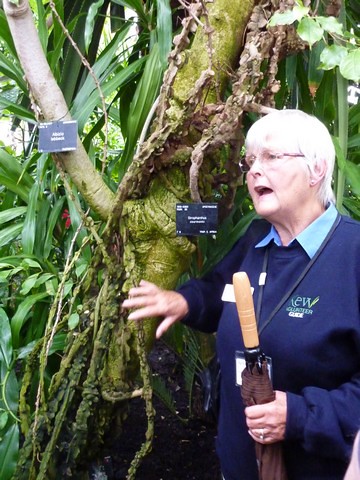 |
| Sheila, guiding her little socks off. (Important tip for anyone wanting to take the free guided tours at Kew: Show up at least 15 minutes before the tour is scheduled to start and sign in. This is mandatory - several people were turned away the Sunday I was there, so don’t say I didn’t warn you.) |
We started with a bit of history, and Kew has a lot of that, having been there in one form or another for 252 years. It started life as an exotic garden owned by Lord Capel John of Tewkesbury in 1759 and was enlarged by the Dowager Princess of Wales, Augusta. It was further expanded by George III. Private collections of exotic plants like those at Kew were status symbols for the wealthy in 18th century, partly due to the proliferation of scientific exploration. The Gardens are still home to the smallest royal palace, Kew Palace, which is a relatively unassuming red brick edifice that was built in 1781 as a Royal Nursery (the kind for young princes and princesses, not the kind for young plants, ironically). However, Kew really came into its own starting in the mid 19th century as a storehouse and showcase for the thousands of specimens of exotic trees and plants that were collected as Englishmen spread their empire across the globe. (Scene: Englishman in pith helmet and crisp linen suit addressing native tribesman: “Hello there my good man. I’d like to propose the following arrangement: you take these lovely glass beads, and we’ll take everything from here to the horizon. God save the Queen!”)
The famous Palm House – Kew’s most iconic structure – was completed in 1848, by architect Decimus Burton (Yes, he was the tenth child in his family, how did you guess?) and shipwright Richard Turner, so its perhaps not unusual that the thing looks a bit like an upturned ship’s hull. It’s famous for being the first large scale structure to be built of wrought iron, and all the panes of glass are hand-blown (and many curve in two different planes.)
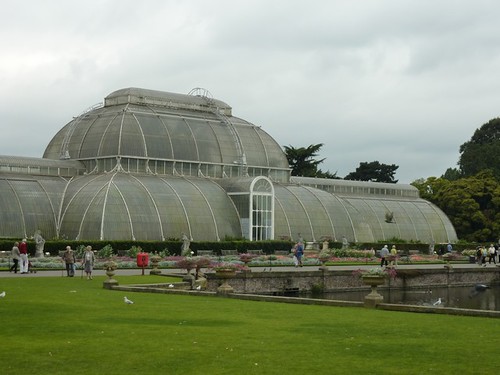 |
| The Palm House, on a cloudy Sunday. I was kind if miffed that it seemed the windows were so dirty, but it’s mostly condensation on the inside. |
Naturally, Sheila took us through the Palm House, and pointed out some really excellent bits of tiriva. For instance, she showed us this fantastic tree whose name I couldn’t be bothered to write down because everything at Kew is labelled with its Latin name. But the tree itself was great – its roots reach down from the skinny trunk like flying buttresses, helping to hold the whole thing stable.
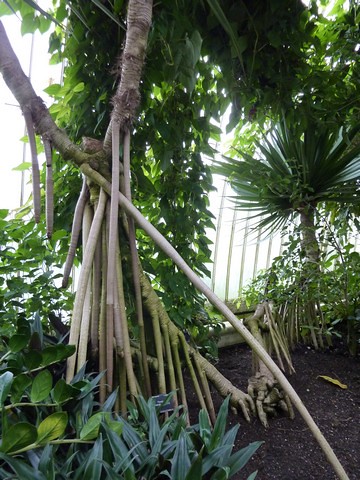 |
| The Flying Buttress Tree (arborem fuga trajectura) (Ok, I just made that up by plunking stuff into Google Translator) |
The Palm House is also home to the world’s oldest pot plant, which is probably not what you’re thinking. Over here they use the term “pot plant” like we use “pot
ted plant” in North America. (I don’t actually know what they say when they mean the not-precisely-legal thing you’re all thinking of.) Anyway, the (probably) world’s oldest pot(ted) plant is an Eastern Cape giant cycad, which looks positively jurassic, and has been at Kew since 1775, thus predating the American and French Revolutions, the invention of the steam engine, the moon landings, and the introduction of New Coke.
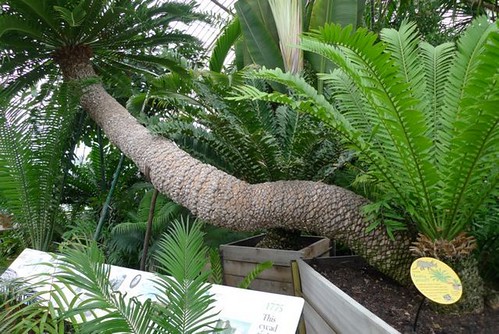 |
| The aged cycad, which has gone distinctly horizontal |
Sheila also told us a sad but heart-warming story about one specific palm tree in the Palm House. As palms trees are a particularly tall and fast-growing species there comes a time in the life of many of the largest of the Palm House palms when the top of the tree starts to threaten the top of the Palm House. At these times the directors at Kew are forced to make the decision to remove the tree, as unfortunate as that may be. This was the case for a palm that Sheila pointed out to us. However, just after the decision was made to remove the tree, it started to flower,
and it is a type of tree that only flowers once in its lifetime and then dies. Thus as if it knew its time had come, the tree put out a display of fantastic drooping clusters and the directors at Kew decided they’d let it live out the end of its days in the Palm House having reached the ripe old age of twelve. (I told you they grow fast.)
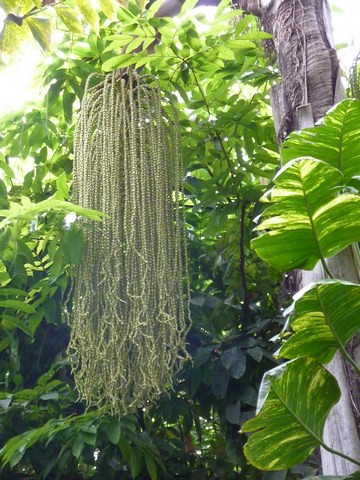 |
| The aforementioned drooping clusters of flower-ish stuff |
Yet Kew is more than just a collection of interesting plants in diverting surroundings. It’s actually one of the world’s largest herbariums (a collection of preserved plants), with over seven million specimens. It also employs more than 650 people, many of whom are not just there to mow the lawn and tend one of the largest compost heaps in Europe, but are actually proper botanists. One of the great works of Kew is the identification and cataloguing of new species of plants, which they do 2-3,000 times each year. There is also a seedbank, one of the world’s largest botanical libraries, and a forensic science department that once “were able to ascertain that the contents of the stomach of a headless corpse found in the river Thames contained a highly toxic African bean.” (from Wikipedia, or possibly from the script of the pilot episode of CSI:Q). They even have an
iPhone app, which I naturally downloaded and used throughout my visit. (It’s well worth the bandwidth.)
However, despite all the exotic plants and beguiling vistas and plucky palm trees, my favourite part of Kew Gardens was an unassuming building tucked away in the Richmond end of the site:
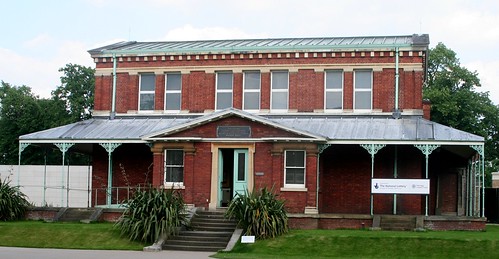 |
| The Marianne North Gallery |
It was recommended by a friend who claimed it was “not to be missed”, and it turns out he was absolutely right. (Thank Jeremy!) The gallery is the home to an enormous collection of paintings by one woman – Marianne North, who was born in 1830 and devoted her life to traveling the world painting the native plant species of the countries she visited. This really is an impressive feat, because though she came from a wealthy family, she did a lot of her traveling alone at a time when that was certainly not the kind of thing women generally did. (Even I, 131 years later, ran into some incredulity when it was discovered I was traveling unaccompanied.) When North at last returned to England she approached the director of Kew Gardens at the time, Sir Joseph Hooker, and offered to pay for the construction of a gallery at Kew for displaying her work. Hooker agreed, and the gallery was built and opened to the public in 1882. (Note to aspiring artists – offering to pay for the construction of your own gallery is a great way to get your work into the public eye!)
And what’s so special about the Marianne North Gallery? Well, let’s just say that North was an exceptionally prolific artist and the view on entering the gallery is… unexpected. Since most of you are unlikely to be there any time soon, I will spoil the surprise and give you a look at the inside of the Marianne North Gallery:
 |
| The gallery contains 832 paintings, all by North, and all displayed like this, in just two modestly-sized rooms. It was “a condition of the bequest of the paintings to Kew on North’s death that the layout of the paintings in the room may not be altered”. (Wikipedia) |
It’s such an arresting thing walking into that first room and seeing the almost absurd number of paintings and their claustrophobic layout (arranged by North herself, over the course of a year) that I think I laughed out loud. It was fantastic. And because it was pouring rain (of course) and I wasn’t due to meet with Phoebe and John for at least half an hour I had the leisure to linger and really take it all in. The paintings are arranged geographically, with all the works of a particular region clustered together, and with tiny numbers painted under each. The numbers correspond to short descriptions on cards that run along the ledge below the paintings (“Angraecum and Urania Moth of Madagascar” and so on). It was easy to while away half an hour just letting my eyes slide over the walls until something popped out that caught my attention, and then letting my eyes wander once again.
What I especially liked was finding paintings of places I’d been to – India and Japan in particular – and seeing that those 130 year old paintings still looked a lot like what I’d seen myself. Yes, there is a preponderance of paintings of trees and flowers and leaves and whatnot, but there are also a lot of paintings of people and buildings and more general landscapes, which I found more interesting than the plants. You can see thumbnails of all of North’s paintings on the Kew website, via
this link.
Eventually the rain slackened and it was time to go meet Phoebe and John, and we hit it off well and had a nice time wandering around that Gardens. I spouted off incessantly with all the bits of trivia that Sheila shared, and we did the
tree-top walk (beware: the elevator is out of order), and went to the
Water Lily House (built specifically to house the giant waterlily) and saw the
pagoda (which looks like a cross between a Chinese pagoda and a large brick bell tower), and went to the
Temperate House (the largest Victorian glass structure still standing), and the
Japanese Garden (including a four-fifths replica of the the Karamon of Nishi Hongan-ji in Kyoto). And I dragged them to the Marianne North Gallery and didn’t tell them what to expect, and their reaction on entering was exactly like mine, which was immensely satisfying.
And then is was Pimm’s O’Clock and we wandered out of the main gate, past a quite-respectable (according to John) cricket match, and ended up at The Greyhound, where they had real ale and Yorkshire puddings the size of hubcaps and Phoebe and I had our picture taken.
 |
| Me and Phoebe at The Greyhound, in a photo that Phoebe didn’t like but it’s not her blog so tough luck for her. |
And thus my day at Kew Gardens ended much more agreeably than it had started. Phoebe and John went off to their next engagement, and I went back to the tube and retrieved my bike from Vauxhall Station (it was still there!) and pedaled my worn-out self home. And I do believe I went to bed early.
(As usual, more photos of my day at Kew can be found in the Flickr set
here.)











2 Comments:
You do make me laugh - especially your last photo comment. A.
Yay - when worlds collide. So glad you guys were able to meet!
Post a Comment